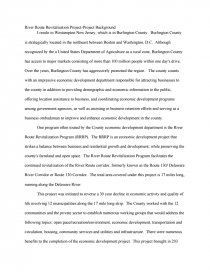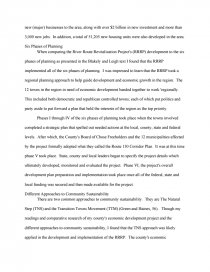River Route Revitalization Project - Project Background
Essay by Mysonisaac1 • March 24, 2013 • Essay • 693 Words (3 Pages) • 1,739 Views
Essay Preview: River Route Revitalization Project - Project Background
River Route Revitalization Project-Project Background
I reside in Westampton New Jersey, which is in Burlington County. Burlington County is strategically located in the northeast between Boston and Washington, D.C. Although recognized by the a United States Department of Agriculture as a rural zone, Burlington County has access to major markets consisting of more than 100 million people within one day's drive. Over the years, Burlington County has aggressively promoted the region. The county counts with an impressive economic development department responsible for attracting businesses to the county in addition to providing demographic and economic information to the public, offering location assistance to business, and coordinating economic development programs among government agencies, as well as assisting in business retention efforts and serving as a business ombudsman to improve and enhance economic development in the county.
One program often touted by the County economic development department is the River Route Revitalization Program (RRRP). The RRRP is an economic development project that strikes a balance between business and residential growth and development, while preserving the county's farmland and open space. The River Route Revitalization Program facilitates the continued revitalization of the River Route corridor, formerly known as the Route 130/ Delaware River Corridor or Route 130 Corridor. The total area covered under this project is 17 miles long, running along the Delaware River.
This project was initiated to reverse a 30 year decline in economic activity and quality of life involving 12 municipalities along the 17 mile long strip. The County worked with the 12 communities and the private sector to establish numerous working groups that would address the following topics: open pace/recreation/environment, economic development, transportation and circulation, housing, community services and utilities and infrastructure. There were numerous benefits to the completion of the economic development project. This project brought in 203 new (major) businesses to the area, along with over $2 billion in new investment and more than 3,000 new jobs. In addition, a total of 51,205 new housing units were also developed in the area.
Six Phases of Planning
When comparing the River Route Revitalization Project's (RRRP) development to the six phases of planning as presented in the Blakely and Leigh text I found that the RRRP implemented all of the six phases of planning. I was impressed to learn that the RRRP took a regional planning approach to help guide development and economic growth in the region. The 12 towns in the region in need of economic development banded together to work 'regionally. This included both democratic and republican controlled towns; each of which put politics and party aside to put
...
...


